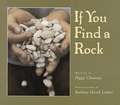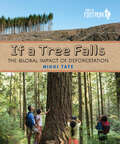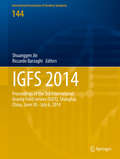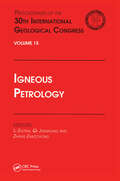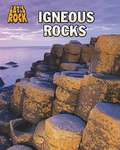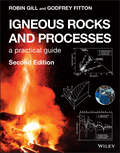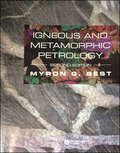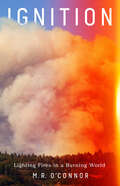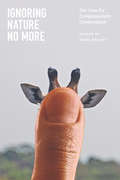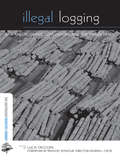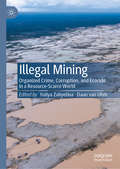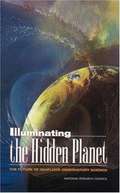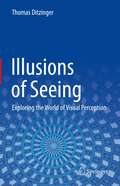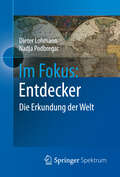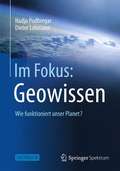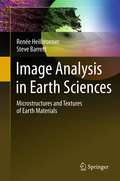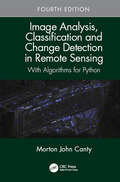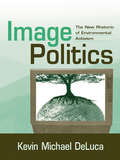- Table View
- List View
If You Find a Rock
by Peggy ChristianCelebrates the variety of rocks that can be found, including skipping rocks, chalk rocks, and splashing rocks.
If You Find a Rock (Into Reading, Read Aloud Module 2 #3)
by Peggy Christian Barbara LemberNIMAC-sourced textbook
If You Want to Visit a Sea Garden
by Kay WeismanDiscover the wonder of ancient sea gardens on the Northwest Coast Sea gardens have been created by First Peoples on the Northwest coast for more than three thousand years. These gardens consist of stone reefs that are constructed at the lowest tide line, encouraging the growth of clams and other marine life on the gently sloped beach. This lyrical story follows a young child and an older family member who set out to visit a sea garden early one morning, as the lowest tides often occur at dawn. After anchoring their boat, they explore the beach, discover the many sea creatures that live there, hear the sputtering of clams and look closely at the reef. They reflect on the people who built the wall long ago, as well as those who have maintained it over the years. After digging for clams, they tidy up the beach, then return home.An author’s note provides further information about sea gardens (also known as clam gardens), which yield a reliable food source and have been traditional places of learning. They have been found along the Pacific coast, from Alaska to British Columbia to Washington State, and some of these gardens are being restored today.The manuscript has been vetted and approved by the scientists of the Clam Garden Network and Kwaxsistalla Wathl’thla Clan Chief Adam Dick. Roy Henry Vickers, whose ancestry includes the Tsimshian, Haida and Heiltsuk First Nations, has created hauntingly beautiful images to accompany the text.Key Text Featuresauthor’s noteCorrelates to the Common Core State Standards in English Language Arts:CCSS.ELA-LITERACY.RI.K.2>With prompting and support, identify the main topic and retell key details of a text.CCSS.ELA-LITERACY.RI.K.6Name the author and illustrator of a text and define the role of each in presenting the ideas or information in a text.
If a Tree Falls: The Global Impact of Deforestation (Orca Footprints #18)
by Nikki TateEvery day more of the world’s forests disappear. Trees are cleared for agriculture, lost in wildfires and harvested for the valuable products they supply. Called the lungs of the planet, forests play a critical role in climate moderation. What happens when they’re gone? Are replanting and afforestation efforts helping? In If A Tree Falls: The Global Impact of Deforestation, author Nikki Tate gives an accessible and balanced look at forest practices throughout history, the growth of industry and the fight for preservation. Global deforestation affects us all. Find out what you can do to protect forests today and keep them healthy for future generations.
Igfs 2014
by Shuanggen Jin Riccardo BarzaghiThis proceedings contains a selection of peer-reviewed papers presented at the IAG Scientific Assembly, Postdam, Germany, 1-6 September, 2013. The scientific sessions were focused on the definition, implementation and scientific applications of reference frames; gravity field determination and applications; the observation and assessment of earth hazards. It presents a collection of the contributions on the applications of earth rotations dynamics, on observation systems and services as well as on imaging and positioning techniques and its applications.
Igneous Petrology: Proceedings of the 30th International Geological Congress, Volume 15
by Li Zhaonai; Qi Jianzhong; Zhang ZhaochongThis volume, based on Symposium on Igneous Petrology held during the 30th International Geological Congress, focuses on intraplate magmatism and diversity and complexity of mechanisms of magma formation.
Igneous Rocks
by Chris OxladeIgneous Rocks looks at how igneous rocks form, change, move, evolve, erode, and are recycled around the world.
Igneous Rocks and Processes
by Robin GillThis book is for geoscience students taking introductory or intermediate-level courses in igneous petrology, to help develop key skills (and confidence) in identifying igneous minerals, interpreting and allocating appropriate names to unknown rocks presented to them. The book thus serves, uniquely, both as a conventional course text and as a practical laboratory manual.Following an introduction reviewing igneous nomenclature, each chapter addresses a specific compositional category of magmatic rocks, covering definition, mineralogy, eruption/ emplacement processes, textures and crystallization processes, geotectonic distribution, geochemistry, and aspects of magma genesis. One chapter is devoted to phase equilibrium experiments and magma evolution; another introduces pyroclastic volcanology. Each chapter concludes with exercises, with the answers being provided at the end of the book.Appendices provide a summary of techniques and optical data for microscope mineral identification, an introduction to petrographic calculations, a glossary of petrological terms, and a list of symbols and units. The book is richly illustrated with line drawings, monochrome pictures and colour plates.Additional resources for this book can be found at: http://www.wiley.com/go/gill/igneous.
Igneous Rocks and Processes: A Practical Guide
by Robin Gill Godfrey FittonIGNEOUS ROCKS AND PROCESSES A practical introduction to igneous petrology for students and practitioners The newly revised Second Edition of Igneous Rocks and Processes: A Practical Guide, delivers an authoritative introduction to igneous petrology and helps students to develop key skills and confidence in identifying igneous materials and in naming and interpreting unknown igneous rocks presented to them. It serves as both a conventional course text and a practical laboratory manual. The authors review igneous nomenclature and subsequently describe specific compositional categories of magmatic rocks. Each chapter covers definitions, mineralogy, eruption and emplacement processes, textures and crystallization processes, geotectonic distribution, geochemistry, and aspects of magma genesis. Additional chapters address phase equilibrium experiments and physical volcanology. This latest edition offers readers extensively updated chapters, as well as access to a companion website with supplementary material. It also provides: Thorough introductions to magmas, magmatic rocks, and magma differentiation Exercises for each chapter, with answers provided at the end A detailed summary of techniques and optical data for mineral identification using a polarizing microscope An introduction to petrographic calculations and an extensive glossary Perfect for geoscience students taking courses in igneous petrology, Igneous Rocks and Processes: A Practical Guide, second edition will also earn a place in the libraries of postgraduate students and researchers in the field.
Igneous and Metamorphic Petrology
by Myron G. BestIgneous and metamorphic petrology has over the last twenty years expanded rapidly into a broad, multifaceted and increasingly quantitative science. Advances in geochemistry, geochronology, and geophysics, as well as the appearance of new analytical tools, have all contributed to new ways of thinking about the origin and evolution of magmas, and the processes driving metamorphism. This book is designed to give students a balanced and comprehensive coverage of these new advances, as well as a firm grounding in the classical aspects of igneous and metamorphic petrology. The emphasis throughout is on the processes controlling petrogenesis, but care is taken to present the important descriptive information so crucial to interpretation. One of the most up-to-date synthesis of igneous and metamorphic petrology available. Emphasis throughout on latest experimental and field data. Igneous and metamorphic sections can be used independently if necessary.
Ignition: Lighting Fires in a Burning World
by M.R. O'ConnorA work of on-the-ground reporting into the science of, and cultural ideas around, wildfires and fire management that challenges the ethos of the conservation movement, offering a hopeful vision of the connection between humans and our environment. In a riveting investigation of the science and ecology of wildfires, journalist M.R. O'Connor ventures into some of the oldest, most beautiful, and remote forests in North America to explore the powerful and ancient relationship between trees, fires, and humans. Along the way, she describes revelatory research in the fields of paleobotany and climate science to show how the world's forests have been shaped by fire for hundreds of millions of years. She also reports on the compelling archeological evidence emerging from the field of ethnoecology that proves how, until very recently, humans were instigators of forest fires, actively molding and influencing the ecosystems around them by inserting themselves into the loop of a natural biological process to start &“good fires.&” As she weaves together first-hand reportage with research and cultural insights, O'Connor also embeds on firelines alongside firefighters and &“pyrotechnicians.&” These highly trained individuals are resurrecting the practice of prescribed burning in an effort to sustain fire-dependent forest ecologies and prevent the catastrophic wildfires that are increasing in frequency and intensity as a result of global warming. Hailing from diverse backgrounds including state and federal agencies, scientific laboratories, and private lands and tribal nations, these fire starters are undertaking a radical and often controversial effort to promote, protect, and expand the responsible use of fire to restore ecological health to landscapes. At the heart of Ignition is a discussion about risk and how our relationship to it as a society will determine our potential to survive the onslaught of climate change.
Ignoring Nature No More: The Case for Compassionate Conservation
by Marc BekoffFor far too long humans have been ignoring nature. As the most dominant, overproducing, overconsuming, big-brained, big-footed, arrogant, and invasive species ever known, we are wrecking the planet at an unprecedented rate. And while science is important to our understanding of the impact we have on our environment, it alone does not hold the answers to the current crisis, nor does it get people to act. In Ignoring Nature No More, Marc Bekoff and a host of renowned contributors argue that we need a new mind-set about nature, one that centers on empathy, compassion, and being proactive. This collection of diverse essays is the first book devoted to compassionate conservation, a growing global movement that translates discussions and concerns about the well-being of individuals, species, populations, and ecosystems into action. Written by leading scholars in a host of disciplines, including biology, psychology, sociology, social work, economics, political science, and philosophy, as well as by locals doing fieldwork in their own countries, the essays combine the most creative aspects of the current science of animal conservation with analyses of important psychological and sociocultural issues that encourage or vex stewardship. The contributors tackle topics including the costs and benefits of conservation, behavioral biology, media coverage of animal welfare, conservation psychology, and scales of conservation from the local to the global. Taken together, the essays make a strong case for why we must replace our habits of domination and exploitation with compassionate conservation if we are to make the world a better place for nonhuman and human animals alike.
Ignoring Nature No More: The Case for Compassionate Conservation
by Marc BekoffFor far too long humans have been ignoring nature. As the most dominant, overproducing, overconsuming, big-brained, big-footed, arrogant, and invasive species ever known, we are wrecking the planet at an unprecedented rate. And while science is important to our understanding of the impact we have on our environment, it alone does not hold the answers to the current crisis, nor does it get people to act. In Ignoring Nature No More, Marc Bekoff and a host of renowned contributors argue that we need a new mind-set about nature, one that centers on empathy, compassion, and being proactive. This collection of diverse essays is the first book devoted to compassionate conservation, a growing global movement that translates discussions and concerns about the well-being of individuals, species, populations, and ecosystems into action. Written by leading scholars in a host of disciplines, including biology, psychology, sociology, social work, economics, political science, and philosophy, as well as by locals doing fieldwork in their own countries, the essays combine the most creative aspects of the current science of animal conservation with analyses of important psychological and sociocultural issues that encourage or vex stewardship. The contributors tackle topics including the costs and benefits of conservation, behavioral biology, media coverage of animal welfare, conservation psychology, and scales of conservation from the local to the global. Taken together, the essays make a strong case for why we must replace our habits of domination and exploitation with compassionate conservation if we are to make the world a better place for nonhuman and human animals alike.
Illegal Logging: Law Enforcement, Livelihoods and the Timber Trade
by Luca Tacconi'This book carefully blends conceptual insights with extensive empirical evidence to navigate the reader through an issue that is still poorly understood [and is] a valuable reference for the development practitioner to understand the fundamental causes of illegal logging, its myriad consequences and the policy choices available to address the problem' Nalin Kishor, Forest Law Enforcement and Governance Coordinator, The World Bank 'An excellent resource for those working to conserve and sustainably manage forests worldwide. It offers an extensive and comprehensive study of illegal logging, bringing together the knowledge and views of experts who examine its roots and social, economic and environmental implications. One of its important contributions is to show that, unless coupled with reform of forestry regulations to take into account local people, law enforcement to curb illegal logging can negatively impact them. Therefore, any effective and fair approach to the problem needs to involve governments, forestry operators and local communities alike' Gonzalo Oviedo, Senior Social Policy Advisor, IUCN In many countries illegal logging now accounts for a large share of the harvest. Once cut, illegal logs feed an insatiable demand for exotic hardwoods in developed and developing countries. The result has been loss of both revenue and biodiversity, and consequently the issue has risen to the top of the global forest policy agenda as one of the major threats to forests, and donors and national governments are starting to develop initiatives to control illegal logging. Yet for such a massive illegal trade, there is surprisingly limited knowledge available as to the major causes of illegal logging and its impacts on biodiversity, people and livelihoods and national economies, and thus plenty of speculation and action without evidence. It is clear that while illegal logging does have negative impacts, it also, controversially, and perhaps paradoxically, benefits many stakeholders, including local communities. This book, written by the world's foremost experts, examines the key issues including law and enforcement, supply and demand, corruption, forest certification, poverty, local livelihoods, international trade and biodiversity conservation. It includes key case studies from forest-rich hotspots in North, South and Central America, equatorial Africa and Indonesia. While there are clearly no easy answers, this book sorts fact from fiction and explores the many dimensions of the causes, impacts and implications for forests, people, livelihoods and forest policy. Published with CIFOR
Illegal Mining: Organized Crime, Corruption, and Ecocide in a Resource-Scarce World
by Daan Van Uhm Yuliya ZabyelinaThis book provides a comprehensive analysis of the illegal extraction of metals and minerals from the perspectives of organized crime theory, green criminology, anti-corruption studies, and victimology. It includes contributions that focus on organized crime-related offences, such as drug trafficking and trafficking in persons, extortion, corruption and money laundering and sheds light on the serious environmental harms caused by illegal mining. Based on a wide range of case studies from the Amazon rainforest through the Ukrainian flatlands to the desert-like savanna of Central African Republic and Australia’s elevated plateaus, this book offers a unique insight into the illegal mining business and the complex relationship between organized crime, corruption, and ecocide. This is the first book-length publication on illegal extraction, trafficking in mined commodities, and ecocide associated with mining. It will appeal to scholars working on organized crime and green crime, including criminologists, sociologists, anthropologists, and legal scholars. Practitioners and the general public may welcome this comprehensive and timely publication to contemplate on resource-scarcity, security, and crime in a rapidly changing world.
Illuminating the Hidden Planet: THE FUTURE OF SEAFLOOR OBSERVATORY SCIENCE
by Committee On Seafloor Observatories: Challenges OpportunitiesDespite our reliance on the ocean and its resources, it remains a frontier for scientific exploration and discovery. Seafloor observatories - unmanned systems of instruments, sensors, and command modules - will have power and communication capabilities to provide support for spatially distributed sensing systems and mobile platforms. Illuminating the Hidden Planet is a voyage to the bottom of the sea, advancing oceanographic science further through long time-series measurements, to discover the mysteries of the deep that have, until now, avoided scientific opportunity.
Illusions Of Safety: Culture And Earthquake Hazard Response In California And Japan
by Risa PalmThis book is based upon work supported by the National Science Foundation under Grant Nos. CMS-9542154 and CMS-9316749. Any opinions, findings, and conclusions or recommendations expressed in this material are those of the authors and do not necessarily reflect the views of the National Science Foundation. We wish to acknowledge the collaboration of Professor Shinobu Kitayama of Kyoto University in sharing in the design of the study. Kitayama developed the application of the concepts drawn from "cultural psychology" to the specific research topic of earthquake hazards response, conducted focus groups in Yaizu and Shimizu that resulted in the development of a cross-cultural questionnaire design, was in charge of the survey execution in Japan, and participated in every stage of the analysis of survey results. Professor Mayumi Karasawa of Shirayuri College in Tokyo coordinated the administration of the survey research in Japan. In Japan, an undergraduate, Takahiko Masuda of Kyoto University, managed the data analysis and coordination with the Oregon team. In Oregon, two graduate students in geography participated in the study design and execution: Tom Kochevar, and Daphne Minton.
Illusions of Seeing: Exploring the World of Visual Perception
by Thomas DitzingerWhy do we need two eyes? Why are all cats grey at night and appear to move faster the day? Why is the sky blue and the setting sun red? This book explains the multifaceted nature of perception, and discusses the mysteries of vision. It provides readers with experiments to help them discover optical illusions and the features of their own perception. Illusions of Seeing begins with a discussion on the essence of light and its perception to the human eye. It presents a comprehensive overview of the basic laws of human perception as well as the fundamentals of good gestalt. Subsequent chapters discuss geometric-optical illusions; the perception of form, brightness, and translucency and their interaction with each other; ambiguous perception, color vision, spatial vision. The book ends with a discussion of the perception of motion and its interaction with color, form, and spatial depth with a full chapter devoted to illusions in our everyday life. Consider this your travel guide in the marvelous world of sight, to experience a completely individual way to understand and improve your own perception.Illusions of Seeing will be of interest to psychologists, physicists, biologists, and undergraduate and graduate students within the field of cognitive psychology.
Im Fokus: Bodenschätze
by Nadja Podbregar Dieter LohmannDer Rohstoffverbrauch der Menschheit steigt. Allein in Deutschland verbraucht jeder im Laufe seines Lebens durchschnittlich rund 1.000 Tonnen Erze, Erden und Mineralien. Auch der Energiebedarf verlangt ständig Nachschub. Doch die Rohstoffreserven sind endlich - entsprechend intensiv ist die Suche nach neuen Lagerstätten oder ganz neuen Ressourcen. Der Autor erklärt in dem Buch u. a., was Handys mit Gorillas zu tun haben, warum Manganknollen zum Rohstoff der Zukunft werden könnten und wo in Deutschland wichtige Bodenschätze und Energiequellen warten.
Im Fokus: Entdecker
by Nadja Podbregar Dieter LohmannWährend es heute auf der Landkarte unserer Erde kaum noch weißen Flecken gibt, waren im 13. Jahrhundert weite Teile "Terra incognita". Licht ins Dunkel brachten erst die Entdecker und Seefahrer - angetrieben von Forschergeist und vom Streben nach Macht und Reichtum. In dem Buch werden auf ebenso spannende wie amüsante Weise ihre wichtigsten Stationen geschildert: Leser begleiten Marco Polo ins alte China und Magellan, als er zum ersten Mal die Welt umsegelt; Kolumbus bei der (Wieder-)Entdeckung Amerikas und Robert Peary beim Wettlauf zum Nordpol.
Im Fokus: Wie funktioniert unser Planet? (Naturwissenschaften im Fokus)
by Nadja Podbregar Dieter LohmannDer Boden unter unseren Füßen erscheint uns unwandelbar und fest. Aber der Eindruck täuscht. Denn in Wirklichkeit ist die Erdkruste alles andere als unbeweglich und verlässlich. So sind die Kontinente immer in Bewegung, Gebirge wachsen in den Himmel, Gesteine bilden sich neu und Meeresböden dehnen sich aus. Doch die Plattentektonik ist nur eines von vielen geologischen Phänomenen, die ihren Ursprung tief im Erdinneren haben. Um zu ergründen, wie unser Planet tickt, haben Geowissenschaftler in den letzten Jahren fast schon eine Reise zum Mittelpunkt der Erde unternommen. Mithilfe von Satelliten, seismischen Wellen und komplexen Simulationen haben sie dabei viele überraschende und faszinierende Erkenntnisse gewonnen. Die Autoren stellen in ihrem Buch einige der wichtigsten Resultate dieser spannenden Detektivarbeit vor. So erklären sie beispielsweise, warum das wahre Gesicht der Erde eine Kartoffel ist oder wieso sich das Erdmagnetfeld viel launischer verhält als gemeinhin angenommen.
Image Analysis in Earth Sciences: Microstructures and Textures of Earth Materials
by Renée Heilbronner Steve BarrettImage Analysis in Earth Sciences is a graduate level textbook for researchers and students interested in the quantitative microstructure and texture analysis of earth materials. Methods of analysis and applications are introduced using carefully worked examples. The input images are typically derived from earth materials, acquired at a wide range of scales, through digital photography, light and electron microscopy. The book focuses on image acquisition, pre- and post-processing, on the extraction of objects (segmentation), the analysis of volumes and grain size distributions, on shape fabric analysis (particle and surface fabrics) and the analysis of the frequency domain (FFT and ACF). The last chapters are dedicated to the analysis of crystallographic fabrics and orientation imaging. Throughout the book the free software Image SXM is used.
Image Analysis, Classification and Change Detection in Remote Sensing: With Algorithms for Python
by Morton John CantyThe fifth edition of this core textbook in advanced remote sensing continues to maintain its emphasis on statistically motivated, data-driven techniques for remote sensing image analysis. The theoretical substance remains essentially the same, with new material on convolutional neural networks, transfer learning, image segmentation, random forests, and an extended implementation of sequential change detection with radar satellites. The tools which apply the algorithms to real remote sensing data are brought thoroughly up to date. As these software tools have evolved substantially with time, the fifth edition replaces the now obsolete Python 2 with Python 3 and takes advantage of the high-level packages that are based on it, such as Colab, TensorFlow/KERAS, Scikit-Learn, and the Google Earth Engine Python API.New in the Fifth Edition: Thoroughly revised to include the updates needed in all chapters because of the necessary changes to the software. Replaces Python 2 with Python 3 tools and updates all associated subroutines, Jupyter notebooks and Python scripts. Presents easy, platform-independent software installation methods with Docker containers. Each chapter concludes with exercises complementing or extending the material in the text. Utilizes freely accessible imagery via the Google Earth Engine and provides many examples of cloud programming (Google Earth Engine API). Examines deep learning examples including TensorFlow and a sound introduction to neural networks. This new text is essential for all upper-level undergraduate and graduate students pursuing degrees in Geography, Geology, Geophysics, Environmental Sciences and Engineering, Urban Planning, and the many subdisciplines that include advanced courses in remote sensing. It is also a great resource for researchers and scientists interested in learning techniques and technologies for collecting, analyzing, managing, processing, and visualizing geospatial datasets.
Image Analysis, Classification and Change Detection in Remote Sensing: With Algorithms for Python, Fourth Edition
by Morton John CantyImage Analysis, Classification and Change Detection in Remote Sensing: With Algorithms for Python, Fourth Edition, is focused on the development and implementation of statistically motivated, data-driven techniques for digital image analysis of remotely sensed imagery and it features a tight interweaving of statistical and machine learning theory of algorithms with computer codes. It develops statistical methods for the analysis of optical/infrared and synthetic aperture radar (SAR) imagery, including wavelet transformations, kernel methods for nonlinear classification, as well as an introduction to deep learning in the context of feed forward neural networks. New in the Fourth Edition: An in-depth treatment of a recent sequential change detection algorithm for polarimetric SAR image time series. The accompanying software consists of Python (open source) versions of all of the main image analysis algorithms. Presents easy, platform-independent software installation methods (Docker containerization). Utilizes freely accessible imagery via the Google Earth Engine and provides many examples of cloud programming (Google Earth Engine API). Examines deep learning examples including TensorFlow and a sound introduction to neural networks, Based on the success and the reputation of the previous editions and compared to other textbooks in the market, Professor Canty’s fourth edition differs in the depth and sophistication of the material treated as well as in its consistent use of computer codes to illustrate the methods and algorithms discussed. It is self-contained and illustrated with many programming examples, all of which can be conveniently run in a web browser. Each chapter concludes with exercises complementing or extending the material in the text.
Image Politics: The New Rhetoric of Environmental Activism (Revisioning Rhetoric Ser.)
by Kevin Michael DeLucaThis exceptional volume examines “image events” as a rhetorical tactic utilized by environmental activists. Author Kevin Michael DeLuca analyzes widely televised environmentalist actions in depth to illustrate how the image event fulfills fundamental rhetorical functions in constructing and transforming identities, discourses, communities, cultures, and world views. Image Politics also exhibits how such events create opportunities for a politics that does not rely on centralized leadership or universal metanarratives. The book presents a rhetoric of the visual for our mediated age as it illuminates new political possibilities currently enacted by radical environmental groups. Chapters in the volume cover key areas of environmental activism such as:*The rhetoric of social movements;*Imaging social movements;*Environmental justice groups; and*Participatory democracy. This book is of interest to scholars and students of rhetorical theory, media and communication theory, visual theory, environmental studies, social change movements, and political theory. It will also appeal to others interested in ecology, radical environmental politics, and activism, and is an excellent supplemental text in advanced undergraduate and graduate level courses in these areas.
